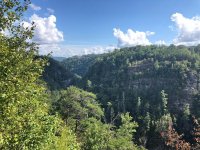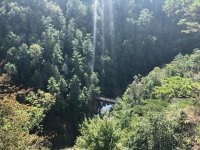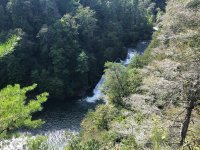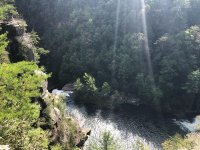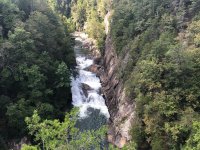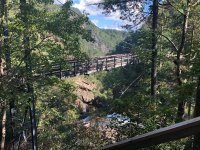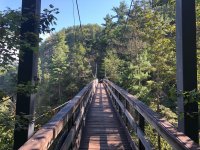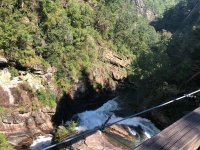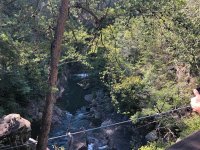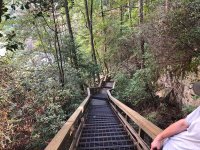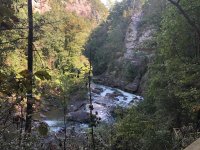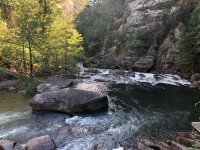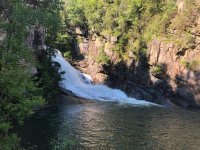longarmwj
New member
There really wasn’t any off-roading involved minus a dirt back road we took, but my Jeep took me here so it counts.
Tallulah Gorge sits right on the borders of Habersham and Rabun Counties in the far Northeast corner of Georgia. The gorge is formed by the Tallulah River cutting through the rock formations for millions of years, resulting in a gorge that in spots is over 1,000 feet deep. The gorge is over two miles long, and features a series of waterfalls that cause the river to drop in elevation 500 feet in less than a mile. It is the deepest canyon East of the Mississippi River.
Just above the falls, Tallulah Falls Lake was created by the construction of the Georgia Railway and Power (now known as Georgia Power) hydroelectric dam in 1913.
This Gorge, despite being beautiful naturally, is beautiful in history as well. This is a semi-comprehensive tour of the gorge.
First and foremost, the drive up there is breathtaking. Nothing beats a North Georgia backroad.

There are two main points of interest for Tallulah Gorge. There is the overlook, and the state park itself. We arrived at the overlook first.
Nice little greeting sign:
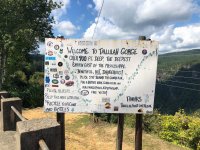
The overlook itself:
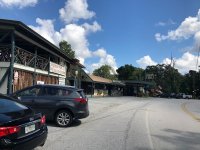
This little shop was awesome!! They had a coke machine that was from the 1940s, and the cokes inside them were ice cold. If you’ve never had a Coke-A-Cola in a glass bottle, pulled from an original coke machine, you’re missing out.

Some views from the observation deck
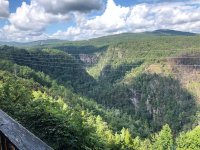
On our way out, we noticed this sign about the famous high rope walker, The Great Wallenda. But more on him later.
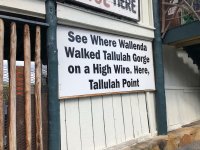
When you arrive to Tallulah Falls State Park, there is a visitors center where you can walk around some exhibits and get an idea of the rich history that this place holds. The first thing that greets you is a model of the original town of Tallulah.
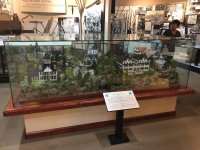
In the early 1800s, many settlers seeked the natural bounty of supplies that the gorge offered. Stone, wood, water, fish, and shelter just to name a few. Many writers and artists seeked the falls for inspiration for their artwork, or to get an accurate idea of a remote wilderness for the stories they were writing. This proved fatal for many of them, because of the harsh terrain and immense drops that would come out of nowhere, especially during night time travel.
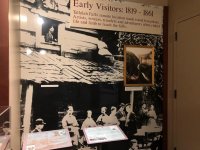
Ever since the early 19th century, Tallulah Falls/Gorge has been a major tourist attraction. In 1882, the Tallulah Falls Railway was constructed, and it turned the city of Tallulah into a bustling city with plenty of hotels and bars to keep the patrons satisfied during their stay. The railway ran from Tallulah, all the way into South Georgia, and it became so popular that on any given weekend, an average of 2,000 people came to visit the attraction. This railway was different from most at the time, because for the duration of the trip they had a live band to entertain the travelers. In the display case they had not only the first 5 tickets ever sold, but also an original music book and clarinet used by one of the band members.
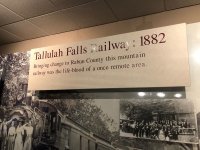
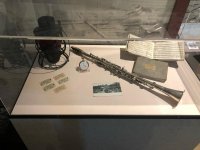
When the golden age of photography first came around, Tallulah Gorge was no exception. The Gorge quickly became the most photographed attraction in the south. This eventually led to interest in the film industry. Movies such as Deliverance, as well as the opening credits for the 1976 film Grizzly were filmed partially in the gorge
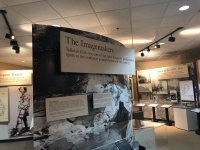
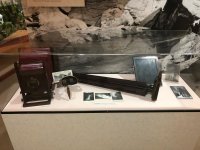
Between the years of 1911 and 1913, the Tallulah Falls Lake dam was constructed to provide power to the bustling resort city that Tallulah had become. Many opposed the dam, because it required flooding the city of Burton, but in the end, the Georgia Assembly was unable to raise the 1 Million dollars required to purchase the Gorge to stop construction. Within the display case were drill bits used to drill into the rock to place dynamite, as well as blasting powder and caps to ignite the dynamite.
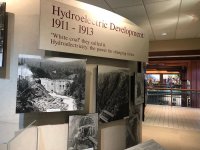
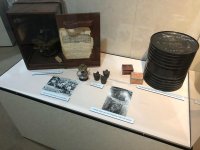
Now remember earlier on how I mentioned the high rope walker? On July 18, 1970 Karl Wallenda became the second person to ever walk across Tallulah Gorge. The first person to ever walk across it was Professor Bachman in 1883 as a publicity stunt for one of the local hotels, however no pictures of this event exist. Inside the display case, they had a section of his high rope, original tickets, a copy of the Guinness Book of World Records that he was featured in, as well as the suite that he practiced the walk in, before deeming it too restricting for the walk and obtaining a new outfit.
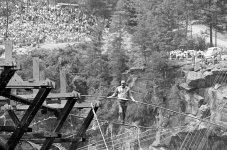
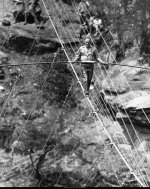
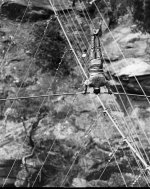
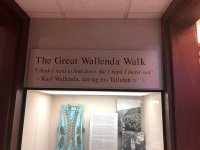
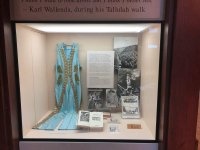
Now, onto the actual trails themselves so that we can get down into the gorge.
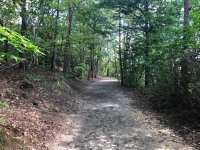
Sent from my iPhone using WAYALIFE mobile app
Tallulah Gorge sits right on the borders of Habersham and Rabun Counties in the far Northeast corner of Georgia. The gorge is formed by the Tallulah River cutting through the rock formations for millions of years, resulting in a gorge that in spots is over 1,000 feet deep. The gorge is over two miles long, and features a series of waterfalls that cause the river to drop in elevation 500 feet in less than a mile. It is the deepest canyon East of the Mississippi River.
Just above the falls, Tallulah Falls Lake was created by the construction of the Georgia Railway and Power (now known as Georgia Power) hydroelectric dam in 1913.
This Gorge, despite being beautiful naturally, is beautiful in history as well. This is a semi-comprehensive tour of the gorge.
First and foremost, the drive up there is breathtaking. Nothing beats a North Georgia backroad.

There are two main points of interest for Tallulah Gorge. There is the overlook, and the state park itself. We arrived at the overlook first.
Nice little greeting sign:

The overlook itself:

This little shop was awesome!! They had a coke machine that was from the 1940s, and the cokes inside them were ice cold. If you’ve never had a Coke-A-Cola in a glass bottle, pulled from an original coke machine, you’re missing out.

Some views from the observation deck

On our way out, we noticed this sign about the famous high rope walker, The Great Wallenda. But more on him later.

When you arrive to Tallulah Falls State Park, there is a visitors center where you can walk around some exhibits and get an idea of the rich history that this place holds. The first thing that greets you is a model of the original town of Tallulah.

In the early 1800s, many settlers seeked the natural bounty of supplies that the gorge offered. Stone, wood, water, fish, and shelter just to name a few. Many writers and artists seeked the falls for inspiration for their artwork, or to get an accurate idea of a remote wilderness for the stories they were writing. This proved fatal for many of them, because of the harsh terrain and immense drops that would come out of nowhere, especially during night time travel.

Ever since the early 19th century, Tallulah Falls/Gorge has been a major tourist attraction. In 1882, the Tallulah Falls Railway was constructed, and it turned the city of Tallulah into a bustling city with plenty of hotels and bars to keep the patrons satisfied during their stay. The railway ran from Tallulah, all the way into South Georgia, and it became so popular that on any given weekend, an average of 2,000 people came to visit the attraction. This railway was different from most at the time, because for the duration of the trip they had a live band to entertain the travelers. In the display case they had not only the first 5 tickets ever sold, but also an original music book and clarinet used by one of the band members.


When the golden age of photography first came around, Tallulah Gorge was no exception. The Gorge quickly became the most photographed attraction in the south. This eventually led to interest in the film industry. Movies such as Deliverance, as well as the opening credits for the 1976 film Grizzly were filmed partially in the gorge


Between the years of 1911 and 1913, the Tallulah Falls Lake dam was constructed to provide power to the bustling resort city that Tallulah had become. Many opposed the dam, because it required flooding the city of Burton, but in the end, the Georgia Assembly was unable to raise the 1 Million dollars required to purchase the Gorge to stop construction. Within the display case were drill bits used to drill into the rock to place dynamite, as well as blasting powder and caps to ignite the dynamite.


Now remember earlier on how I mentioned the high rope walker? On July 18, 1970 Karl Wallenda became the second person to ever walk across Tallulah Gorge. The first person to ever walk across it was Professor Bachman in 1883 as a publicity stunt for one of the local hotels, however no pictures of this event exist. Inside the display case, they had a section of his high rope, original tickets, a copy of the Guinness Book of World Records that he was featured in, as well as the suite that he practiced the walk in, before deeming it too restricting for the walk and obtaining a new outfit.





Now, onto the actual trails themselves so that we can get down into the gorge.

Sent from my iPhone using WAYALIFE mobile app
Last edited:

